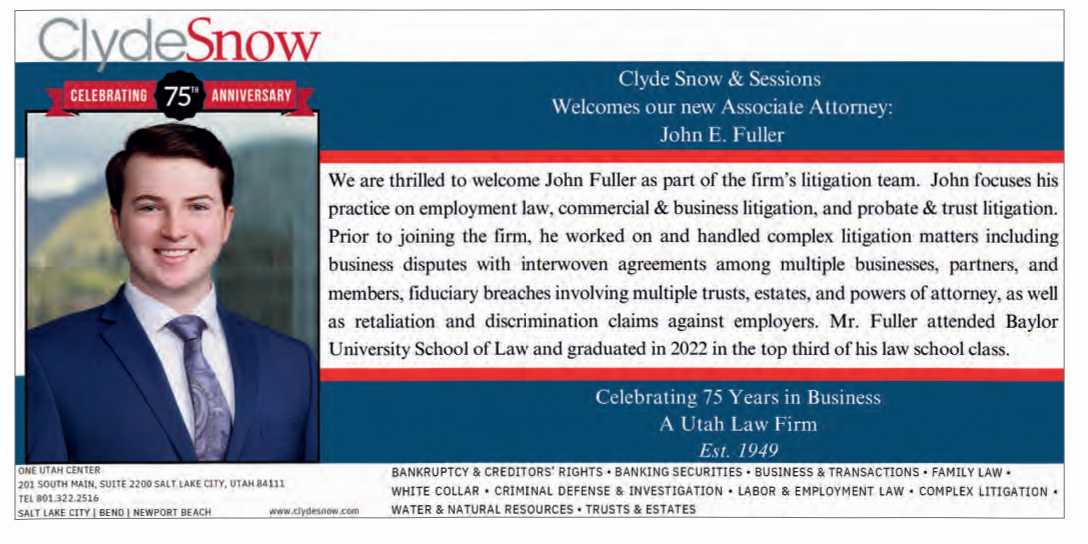April 2025
Article
by Jeff Teichert
Justice Scalia famously declared, "Administrative law is not for sissies" and called Chevron U.S.A., Inc. v. NRDC, Inc., 467 U.S. 837 (1984), "a highly important decision" while contending for its full and forceful application. Antonin Judicial Deference to Administrative Interpretations of law, 1989 Duke LJ. 511, 511-12. Chevron required judges to defer to "permissible" agency interpretations of statutes. Notwithstanding Justice Scalia's early support of Chevron, he later doubted its compatibility with the role of the courts and the Administrative Procedure Act (APA). See Perez v. Mortgage Bankers Ass'n., 575 U.S. 92, 109-110 (2015) (Scalia, J., concurring).
Justice Scalia's successor would bring greater attention to Chevron and the problems it presented. Before he was even appointed to the United States Supreme Court, Judge Neil Gorsuch wrote that Chevron may have been wrongly decided:
There's an elephant hi the room with us today. We have studiously attempted to work our way around it and even left it unremarked. But the fact is Chevron and Brand Apermit executive bureaucracies to swallow huge amounts of core judicial and legislative power and concentrate federal power in a way that seems more than a little difficult to square with the Constitution of the framers' design. Maybe the time has come to face the behemoth.
Gutierrez-Brizuela v. Lynch, 834 F.3d 1142, 1149 (10th Cir. 2016) (Gorsuch, J., concurring). Judge Gorsuch made these statements in a case where an agency reinterpreted a statute and, by so doing, overturned an authoritative judicial interpretation. Judge Gorsuch wrote" [i]f you accept Chevron's claim that legislative ambiguity represents a license to executive agencies to render authoritative judgments about what a statute means, Brand X's rule requiring courts to overturn their own contrary judgments does seem to follow pretty naturally." Id. at 1151.
In Loper Bright Enters, v. Raimondo, 603 U.S. 369 (2024), the United States Supreme Court overruled Chevron, fundamentally transforming the landscape of federal administrative law. Under Loper Bright, courts are to employ traditional judicial tools of statutory interpretation, rather than deferring to plausible interpretations rendered by the administering agency. This article will discuss: (1) Chevron and the problems that led to its overruling, (2) the reasoning of Loper Bright, including the possible influence of the concurring opinions, (3) whether Loper Bright will affect Utah courts' approach to administrative law cases, and (4) suggested questions to guide future developments in administrative law.
Chevron Deference: The High-Watermark of Agency Interpretation of the Law
In Chevron, the United States Supreme Court addressed a dispute about the meaning of "stationary source" of pollution under the Clean Air Act (Act). Chevron supported the Environmental Protection Agency's (EPA's) regulation allowing states to interpret the term "stationary source" to treat all pollution-emitting devices within the same industrial group as a single source for permitting purposes. Chevron, 467 U.S. at 840-4L The D.C. Circuit Court of Appeals had held that each device was a separate stationary source under the Act. See Nat'l Res. Def. Council, Inc. v. Gorsuch, 685 F.2d 718 (D.C. Cir. 1982).
Chevron established a two-step framework for reviewing agency interpretations of statutes. First, if Congressional intent was clear on the specific issue, "that is the end of the matter" and the court would follow the plain language of the statute regardless of the agency's interpretation. 467 U.S. at 842-43. Second, if the statute was silent or ambiguous on the issue, the court would determine whether the agency's interpretation was "based on a permissible construction of the statute." Id. This framework, commonly known as Chevron deference, afforded agencies latitude to make policy by filling "gap[s]" in statutes. Id.
JEFFREY B. TEICHERT practices business litigation and appeals at Teichert Law Office, PLLC in Salt Lake City, Utah.

Chevron held that, where the statute granted regulatory authority, the agency's regulations were to be "given controlling weight unless they were arbitrary, capricious, or manifestly contrary to the statute." Id. at 843-44. Where a legislative delegation was implied by ambiguity, the courts would defer to the agency regulation if it "represent [ed] a reasonable accommodation of conflicting policies." Id. at 845 (quoting United States v. Shimer, 367 U.S. 374, 383 (1961)). Chevron held that the text and legislative history of the Act did not plainly reveal the intent of Congress about whether "stationary source" referred to all devices in an industrial group as a single source. Id. at 861-62. Thus, Chevron deferred to the EPA's interpretation.
Chevron reasoned that courts should not resolve policy disputes by declaring the meaning of ambiguous statutory language. The Court said that "Judges are not experts in the field, and are not part of either political branch of the Government" and thus should not "reconcile competing political interests ... on the basis of the judges' personal policy preferences." Id. at 865. Chevron concluded that "' [o]ur Constitution vests such responsibilities in the political branches.'" Id. at 866 (quoting TVA v. Hill, 437 U.S. 153, 195 (1978)).
Invoking the "political branches" and "experts in the field," Chevron rhetorically embraced two principles in tension with each other - government by experts and government by the people. The first fine of thinking is that the agencies employ experts in their fields who are more qualified to make policy. The second fine of thinking is that the President is elected and therefore the executive branch is in a better position than the courts to make policy decisions reflecting the popular will. Id. at 865.
Restoring the Separation of Powers
Justice Kagan proclaimed in a dissent that Chevron was "a cornerstone of administrative law." Loper Bright, 603 U.S. at 448 (Kagan, J. dissenting). The federal district court noted in Loper Bright the APA's "narrow' standard of review," that '"a court is not to substitute its judgment for that of the agency'" and '"will defer to the [agency's] interpretation of what [a statute] requires so long as it is 'rational and supported by the record.'" Loper Bright Enters, v. Raimondo, 544 F.Supp.3d 82, 99 (D.D.C. 2021) (citations omitted). The federal district court applied Chevron deference and upheld the Secretary of Commerce's regulations for certain New England fisheries implementing a monitoring program which required fishermen to pay out of pocket for their own monitoring. Loper Bright, 544 F.Supp.3d at 97. The First Circuit affirmed the decision, relying on a "default norm" that regulated entities must pay compliance costs, rather than referencing statutory language. Relentless, Inc. v. United States DOC, 62 F.4th621, 630 (1st Cir. 2023).
The Loper Bright Court decisively overruled Chevron by a 6-2 majority. Chief Justice Roberts authored the majority opinion, joined by Justices Thomas, Alito, Gorsuch, Kavanaugh, and Barrett. Justices Thomas and Gorsuch also filed separate concurring opinions. Justice Kagan wrote a dissenting opinion, joined by Justice Sotomayor. Justice Jackson recused herself from the case.
The Loper Bright majority noted that Congress enacted the APA in 1946 "'as a check upon administrators whose zeal might otherwise have carried them to excesses not contemplated in legislation creating their offices.'" Loper Bright, 603 U.S. at 391 (citation omitted). The APA directs that "the reviewing court shall decide

all relevant questions of law, interpret constitutional and statutory provisions, and determine die meaning or applicability of the terms of an agency action." 5 U.S.G. § 706. The APA "was the culmination of a 'comprehensive rethinking of the place of administrative agencies in a regime of separate and divided powers.'" Loper Bright, 603 U.S. at 391 (quoting Bowen v. Michigan Acad, of Fam. Physicians, 476 U.S. 667,670-671 (1986)). Thus, a primary purpose of the APA was to check the power of the executive branch - not give it even greater deference as Chevron did. Loper Bright ultimately recognized this, stating that Chevron deference was [h]eedless of the original design' of the APA." Id. at 398 (quoting Perez v. Mortg. Bankers Ass'n, 575 U.S. 92, 109 (2015)).
Loper Bright embraces respect for agencies acting within their statutory authority (if they stay within the limits of that authority) but is also emphatic that "Courts must exercise their independent judgment" and "under the APA may not defer to an agency interpretation of the law simply because a statute is ambiguous." Id. at 412. While Loper Bright invokes the traditional role of judges under the Constitution, it is based on the language of the APA that requires judges to exercise independent judgment. While Justice Thomas joined the majority in that view, he added a concurring opinion, joined by Justice Gorsuch, to underscore the "more fundamental problem" that "Chevron deference also violates our Constitution's separation of powers[.]" Id. at 413 (Thomas, J., concurring).
Article I, Section 1, of the United States Constitution states that "AU legislative Powers herein granted shah be vested in a Congress of the United States, which shall consist of a Senate and House of Representatives." Yet, as of 2023, the Code of Federal Regulations was 190,260 pages long, indicating that the executive branch is responsible for more than three times the volume of legislation enacted by Congress. The George Washington University Regulatory Studies Center, Total Pages Published in Code of Federal Regulations,...
